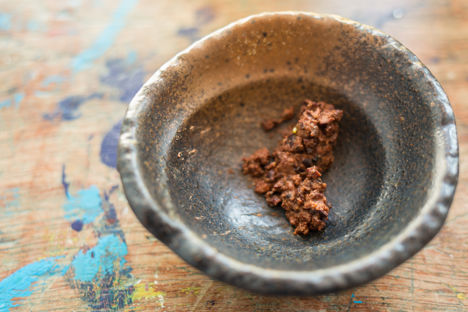Miso is a fermented seasoning paste made from soy beans or barley, fermented with the all-round wonder grain, koji. Fermentation times range from one week to several years, which effects the flavour greatly. Younger misos are sweeter and have a creamy, nutty flavour, and are best suited to dressings and miso soup. Older misos are saltier in flavour and much richer. These ones are darker in colour and pair well with more robust flavours such as steak or stews.
Making your own miso may sound daunting but all you need is the right equipment and a little patience. The recipe itself is actually very easy – it’s more about getting your head around the process.
These recipes for sweet and salty misos come from Dean Parker, head chef of The Manor in Clapham. Dean generally reduces the salt content in his misos and ferments at a relatively high temperature which reduces the fermentation time, which is of course very useful if you want to give miso-making a try but don’t fancy waiting months! It also allows you to experiment with a number of different flavours.
You can make sweet or salty misos. Sweet misos are comprised of 3–7% salt and require at least 33% koji to bean. These are the quickest to make, requiring 3–30 days of fermentation depending on the temperature, 15°C–25°C being ideal. Salty misos need as much as 16–25% salt and at least 10% koji to bean. It will also need 5% live miso paste (regular miso paste) which helps to act as a starter. Because of the salt content this miso needs to ferment slower, so a cool, dark area such as a cellar is ideal and takes 1–3 months (or longer if you want to age it for a more complex flavour).
Very high in protein, the soy bean is known throughout East Asia as ‘the meat of the fields’. Unfortunately, this dense bean is difficult to digest, which is where fermentation comes in. Fermenting the beans helps to break down complex proteins into amino acids, which pre-digests the beans. The first bean ferments were pioneered a thousand years ago by Buddhists in China seeking alternatives to meat-based diets. In Japan, the consumption of miso spread beyond the Buddhist monasteries during the Kamakura period (1185 to 1333), and is now a staple flavour of Japanese cuisine.
Metric
Imperial
- 250g of soy beans, (or whichever grain/pulse/seed you choose)
- 125g of dried rice koji, make your own or available online
- 250ml of water
- 18g of salt
- 250g of soy beans, (or whichever grain/pulse/seed you choose)
- 40g of dried rice koji, make your own* or available online
- 250ml of water
- 50g of salt
- 15g of miso paste
Get in touch
Please sign in or register to send a comment to Great British Chefs.


